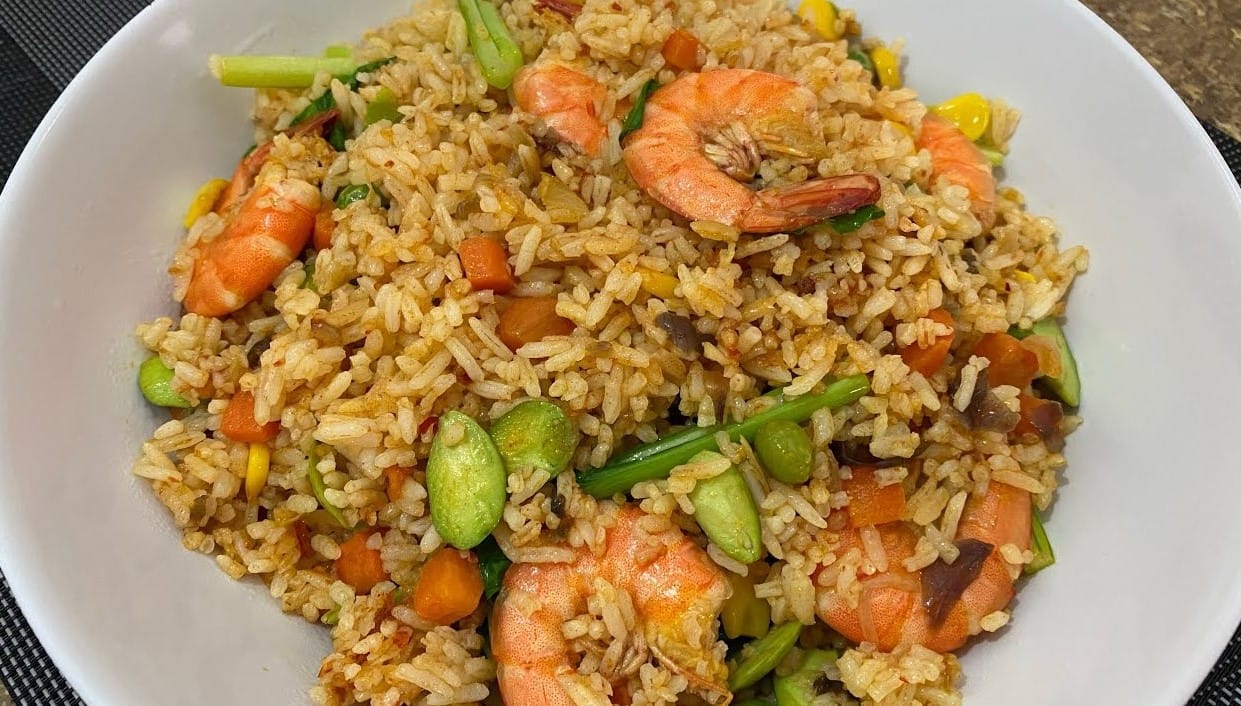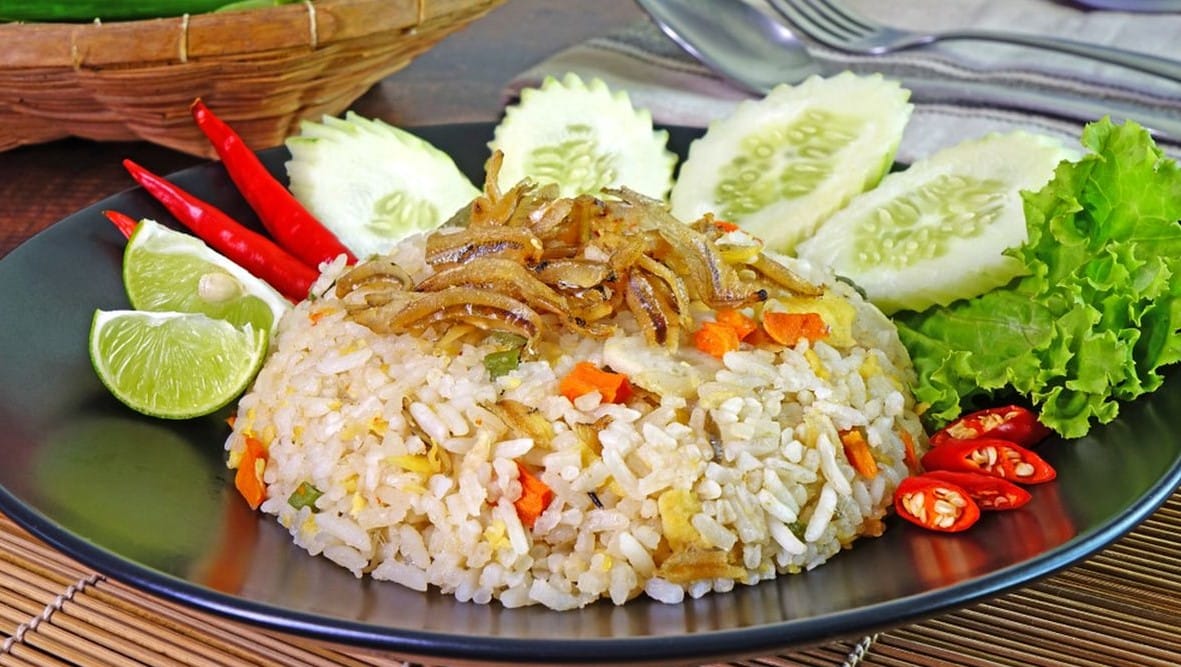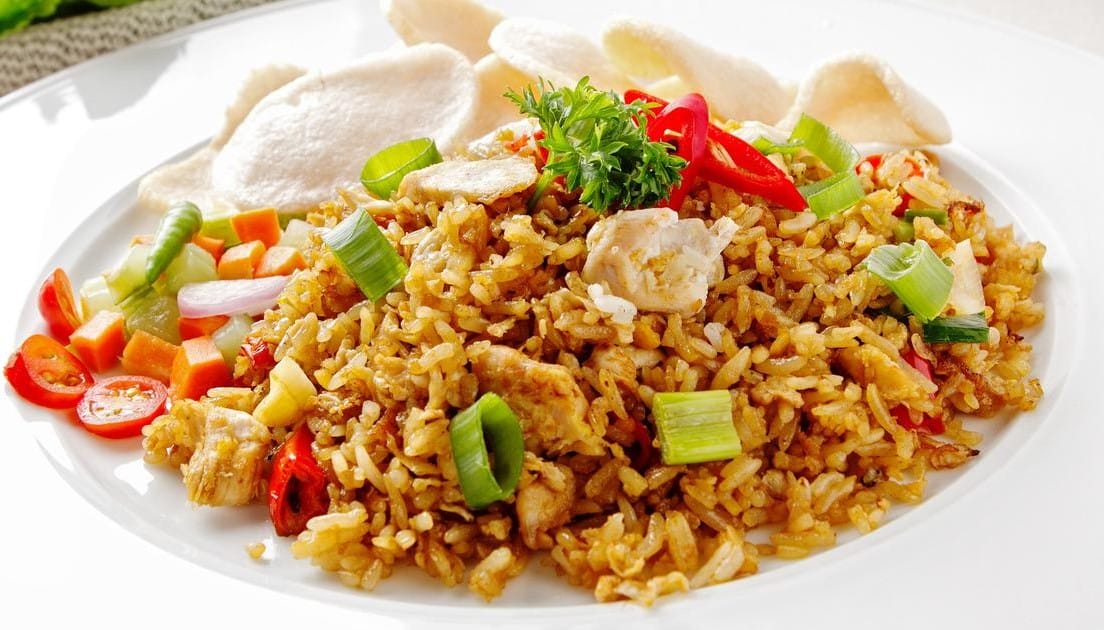A Humble Dish with Bold Flavors
The aroma hits you first. Garlic and shallots sizzle in hot oil, releasing a fragrance that fills the kitchen and beckons you closer. The scent of fried rice permeates the air, a comforting and familiar smell that promises satisfaction. This is nasi goreng kampung, a dish that embodies simplicity yet delivers bold flavors with every bite.
Nasi goreng translates to “fried rice” in Indonesian, while kampung means “village.” Together, they describe a village-style fried rice that is both unpretentious and deeply flavorful. It is a staple of Indonesian cuisine, celebrated for its ability to transform simple ingredients into a meal that is both hearty and delicious.

Origins in Necessity
Nasi goreng kampung was born out of necessity, a testament to the resourcefulness of villagers who refused to waste food. Leftover rice, a common occurrence in many households, was repurposed into breakfast. By adding a few vegetables and perhaps an egg, a new meal was created, one that was both economical and satisfying.
This humble dish quickly spread beyond the confines of village life, finding its way into the hearts and homes of people across Indonesia. It even crossed borders into Malaysia, where it became equally beloved. Today, nasi goreng kampung is a ubiquitous presence, sold by street vendors and served in upscale restaurants alike. Yet, despite its widespread popularity, the soul of the dish remains unchanged. It is still simple, satisfying, and delicious.
Key Ingredients
At the heart of nasi goreng kampung is rice, specifically day-old rice. This is not merely a matter of convenience; day-old rice is drier and fries up better, resulting in a texture that is both chewy and slightly crispy. Freshly cooked rice, on the other hand, tends to become mushy when fried.
Aromatics play a crucial role in building the flavor profile of nasi goreng kampung. Garlic and shallots form the base, their flavors melding together as they sizzle in hot oil. Some cooks add ginger for an extra layer of warmth and complexity. These ingredients create a foundation of flavor that is both robust and inviting.
Vegetables are a versatile component of nasi goreng kampung, with the choice often dictated by what is available. Carrots and green beans are common additions, providing color and crunch. Some cooks opt for cabbage or bell peppers, each bringing its unique taste and texture to the dish.
Protein is optional but frequently included. A fried egg is traditional, its runny yolk adding richness to the rice. Others might add chicken or shrimp for a heartier meal, while vegetarians often turn to tofu as a protein source.
The seasoning is straightforward yet effective. Soy sauce imparts saltiness and umami, while a touch of sugar balances the flavors. Chili paste is added for heat, its fiery kick elevating the dish to new heights.

Cooking Technique
The cooking process for nasi goreng kampung is fast and requires high heat. A wok is ideal for this purpose, but a large frying pan can also suffice. The key is to maintain a high temperature throughout the cooking process.
Begin with the aromatics. Fry the garlic and shallots until they are fragrant and golden brown. This step is crucial, as it sets the stage for the flavors to come. Next, add the rice, stirring continuously to ensure it heats evenly and develops a slight crispiness.
Once the rice is hot, add the vegetables. They should be cooked until they are crisp-tender, retaining a bit of bite. Overcooking them will result in a mushy texture, which is undesirable.
The protein is added next. If using an egg, push the rice and vegetables to one side of the pan and crack the egg into the empty space. Scramble it quickly, then mix it with the rice. If using other proteins, ensure they are cooked through before combining them with the rice.
Finally, add the seasoning. Soy sauce, sugar, and chili paste are stirred in, coating the rice and vegetables in a savory, spicy glaze. The rice should take on a golden brown hue, a sign that it is ready to be served.

Variations on a Theme
Every cook has their version of nasi goreng kampung, each adding their personal touch to the dish. Some prefer to use kecap manis, a sweet soy sauce that adds a hint of caramelized sweetness. Others might opt for fish sauce, which provides depth and a subtle brininess.
In Malaysia, belacan, a type of shrimp paste, is often added. Its pungent, salty flavor is an acquired taste but beloved by many. Some cooks like to top their nasi goreng with a fried egg, allowing the yolk to mix with the rice, while others prefer to incorporate the egg during cooking. There is no wrong way to enjoy nasi goreng kampung, only personal preference.
More Than Just a Meal
Nasi goreng kampung is more than just a meal; it is a cultural touchstone that represents resourcefulness and ingenuity. It is a dish that makes something delicious out of leftovers, a practice that resonates with people from all walks of life.
The dish transcends class lines, enjoyed by both the poor and the wealthy. It is comfort food for millions, a reminder of home and family. In Indonesia, nasi goreng is often eaten for breakfast, but it is equally popular at any time of day. Late-night nasi goreng is a favorite among those seeking a satisfying meal after a night out.

Cooking at Home
Making nasi goreng kampung at home is a straightforward process that requires minimal equipment. A pan, a spatula, and a stove are all you need to recreate this beloved dish in your kitchen.
The ingredients are simple and likely already in your pantry. Rice, eggs, and vegetables form the basis of the dish, with soy sauce and chili paste providing seasoning. The key to success is preparation. Have all your ingredients ready before you begin cooking, as the process moves quickly once you start.
Step-by-Step Guide
- Cook the rice a day ahead. Allow it to cool completely before storing it in the fridge. This step is crucial for achieving the right texture.
- Finely chop garlic and shallots, ensuring they are ready to go when you start cooking.
- Cut your chosen vegetables into small, uniform pieces for even cooking.
- Heat oil in a wok or large frying pan over high heat.
- Add the garlic and shallots, frying them until they are fragrant and golden.
- Add the rice, stirring continuously to prevent sticking and ensure even heating.
- Add the vegetables, cooking them until they are crisp-tender.
- Push the rice and vegetables to one side of the pan. Crack an egg into the empty space and scramble it quickly.
- Mix the scrambled egg with the rice and vegetables.
- Add soy sauce, sugar, and chili paste, stirring to coat the rice evenly.
- Continue stir-frying until everything is well-mixed and hot.
Tips for Success
To achieve the best results, use day-old rice. Fresh rice tends to become mushy when fried, while day-old rice maintains its structure and texture.
Avoid overcrowding the pan, as this can lead to uneven cooking. If necessary, cook in batches to ensure each ingredient is properly fried.
Keep the heat high throughout the cooking process. This helps to develop the desired texture and flavor in the rice.
Taste the dish as you go, adjusting the seasoning to suit your preferences. Everyone’s palate is different, and the beauty of nasi goreng kampung is its adaptability.

Serving Suggestions
Nasi goreng kampung is often served with a variety of sides that complement its flavors. Sliced cucumber adds a refreshing crunch, while tomatoes provide a burst of acidity that balances the richness of the dish.
Kerupuk, Indonesian prawn crackers, are a popular accompaniment, adding a satisfying crunch to each bite. Some people enjoy adding a fried egg on top, allowing the yolk to mix with the rice for added richness.
Health Considerations
Nasi goreng kampung can be part of a healthy diet when prepared with care. It is a balanced meal, providing carbohydrates from the rice, protein from the egg, and vitamins from the vegetables.
To make the dish healthier, consider using less oil during cooking. Increasing the proportion of vegetables can also boost the nutritional content. For those seeking a healthier alternative to white rice, brown rice can be used, offering additional fiber and nutrients.
The Global Appeal
Nasi goreng kampung has garnered fans worldwide, its appeal transcending cultural and geographical boundaries. The late Anthony Bourdain famously praised it, calling it “the perfect breakfast” during his travels in Indonesia.
In the Netherlands, nasi goreng is a popular dish, a culinary remnant of the country’s colonial ties to Indonesia. Even in the United States, nasi goreng is gaining popularity, appearing on the menus of Asian fusion restaurants and delighting diners with its bold flavors.
Conclusion
Nasi goreng kampung is a testament to the power of simplicity. It is a dish that proves great food does not require fancy ingredients or elaborate techniques. Instead, it relies on the quality of its components and the skill of the cook to transform humble ingredients into something extraordinary.
This dish is more than just a recipe; it is a way of thinking about food. It encourages creativity and resourcefulness, challenging cooks to make the most of what they have on hand. In doing so, it celebrates the ingenuity and adaptability of those who prepare it.
Try making nasi goreng kampung at home, experimenting with different ingredients and flavors to make it your own. Embrace the spirit of the dish, which is both humble and infinitely adaptable. In the end, nasi goreng kampung is more than a meal; it is a celebration of culinary tradition and innovation, a perfect meal for any time of day. Simple, satisfying, and deeply rooted in culture, it is a dish that continues to captivate and inspire.
